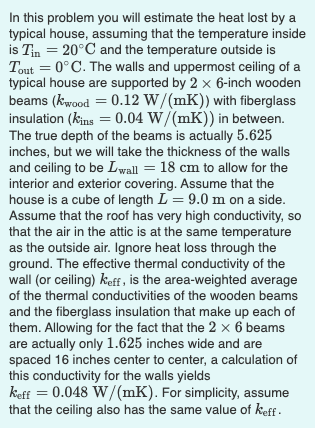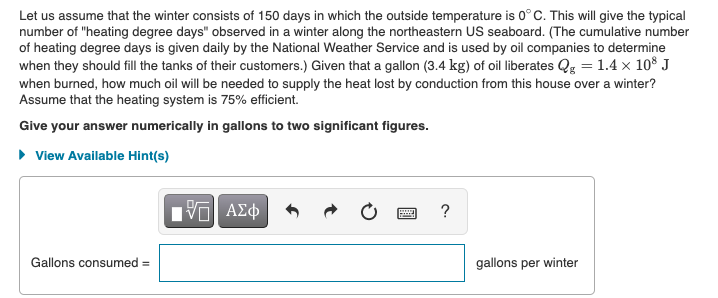las tion (kins = 0.04 W/(mK)) in between. ue depth of the beams is actually 5.625 , but we will take the thickness of the walls eiling to be Lwall = 18 cm to allow for the r and exterior covering. Assume that the is a cube of length L = 9.0 m on a side. he that the roof has very high conductivity, so e air in the attic is at the same temperature outside air. Ignore heat loss through the d. The effective thermal conductivity of the or ceiling) keff , is the area-weighted average thermal conductivities of the wooden beams wood glass o fiborglacs inculation that mako up nch of
las tion (kins = 0.04 W/(mK)) in between. ue depth of the beams is actually 5.625 , but we will take the thickness of the walls eiling to be Lwall = 18 cm to allow for the r and exterior covering. Assume that the is a cube of length L = 9.0 m on a side. he that the roof has very high conductivity, so e air in the attic is at the same temperature outside air. Ignore heat loss through the d. The effective thermal conductivity of the or ceiling) keff , is the area-weighted average thermal conductivities of the wooden beams wood glass o fiborglacs inculation that mako up nch of
Principles of Physics: A Calculus-Based Text
5th Edition
ISBN:9781133104261
Author:Raymond A. Serway, John W. Jewett
Publisher:Raymond A. Serway, John W. Jewett
Chapter17: Energy In Thermal Processes: The First Law Of Thermodynamics
Section: Chapter Questions
Problem 69P: An aluminum rod 0.500 m in length and with a cross-sectional area of 2.50 cm2 is inserted into a...
Related questions
Question

Transcribed Image Text:In this problem you will estimate the heat lost by a
typical house, assuming that the temperature inside
is Tin = 20°C and the temperature outside is
Tout = 0°C. The walls and uppermost ceiling of a
typical house are supported by 2 x 6-inch wooden
beams (kwood = 0.12 W/(mK)) with fiberglass
insulation (kins = 0.04 W/(mK)) in between.
The true depth of the beams is actually 5.625
%3D
%3D
%3D
inches, but we will take the thickness of the walls
and ceiling to be Lwall = 18 cm to allow for the
interior and exterior covering. Assume that the
house is a cube of length L = 9.0 m on a side.
Assume that the roof has very high conductivity, so
that the air in the attic is at the same temperature
as the outside air. Ignore heat loss through the
ground. The effective thermal conductivity of the
wall (or ceiling) keff , is the area-weighted average
of the thermal conductivities of the wooden beams
and the fiberglass insulation that make up each of
them. Allowing for the fact that the 2 x 6 beams
are actually only 1.625 inches wide and are
spaced 16 inches center to center, a calculation of
this conductivity for the walls yields
keff = 0.048 W/(mK). For simplicity, assume
that the ceiling also has the same value of keff -

Transcribed Image Text:Let us assume that the winter consists of 150 days in which the outside temperature is 0° C. This will give the typical
number of "heating degree days" observed in a winter along the northeastern US seaboard. (The cumulative number
of heating degree days is given daily by the National Weather Service and is used by oil companies to determine
when they should fill the tanks of their customers.) Given that a gallon (3.4 kg) of oil liberates Qg = 1.4 x 10° J
when burned, how much oil will be needed to supply the heat lost by conduction from this house over a winter?
Assume that the heating system is 75% efficient.
Give your answer numerically in gallons to two significant figures.
• View Available Hint(s)
?
Gallons consumed =
gallons per winter
Expert Solution
This question has been solved!
Explore an expertly crafted, step-by-step solution for a thorough understanding of key concepts.
Step by step
Solved in 3 steps

Knowledge Booster
Learn more about
Need a deep-dive on the concept behind this application? Look no further. Learn more about this topic, physics and related others by exploring similar questions and additional content below.Recommended textbooks for you

Principles of Physics: A Calculus-Based Text
Physics
ISBN:
9781133104261
Author:
Raymond A. Serway, John W. Jewett
Publisher:
Cengage Learning


Physics for Scientists and Engineers, Technology …
Physics
ISBN:
9781305116399
Author:
Raymond A. Serway, John W. Jewett
Publisher:
Cengage Learning

Principles of Physics: A Calculus-Based Text
Physics
ISBN:
9781133104261
Author:
Raymond A. Serway, John W. Jewett
Publisher:
Cengage Learning


Physics for Scientists and Engineers, Technology …
Physics
ISBN:
9781305116399
Author:
Raymond A. Serway, John W. Jewett
Publisher:
Cengage Learning

College Physics
Physics
ISBN:
9781285737027
Author:
Raymond A. Serway, Chris Vuille
Publisher:
Cengage Learning

Physics for Scientists and Engineers: Foundations…
Physics
ISBN:
9781133939146
Author:
Katz, Debora M.
Publisher:
Cengage Learning